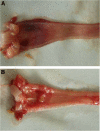The role of the 5-hydroxytryptamine pathway in reflux-induced esophageal mucosal injury in rats
- PMID: 23092450
- PMCID: PMC3534590
- DOI: 10.1186/1477-7819-10-219
The role of the 5-hydroxytryptamine pathway in reflux-induced esophageal mucosal injury in rats
Abstract
Background: Dysfunction of the 5-hydroxytryptamine (5-HT) signaling pathway can lead to gastrointestinal motility and secretion abnormalities and to visceral hypersensitivity. The aim of this study is to investigate the role of 5-HT in reflux-induced esophageal mucosal injury.
Methods: Fifty 8-week-old male Sprague-Dawley (SD) rats were randomly divided into a gastroesophageal reflux (GER) model group (30 rats) and a sham surgery control group (20 rats). Four weeks after surgery, the esophageal mucosa was collected for histological evaluation, 5-HT concentrations, and 5-HT selective reuptake transporter (SERT) mRNA and 5-HT4 receptor (5-HT4R) protein expressions.
Results: Twenty-seven rats in the GER model group survived, and three rats died. Histologically, in the GER model group, 20 rats had reflux esophagitis (RE group), and 7 rats had non-erosive reflux disease (NERD group). The 5-HT levels in the esophageal tissue from the RE group were significantly higher than those from the control and NERD groups. Both the RE and NERD groups showed significant increases in SERT mRNA expression of the esophageal mucosa than that of the controls, and the SERT mRNA level in the RE group was significantly higher than that in the NERD group. The 5-HT4R protein level of the esophageal mucosa in the RE group was significantly lower than that in the controls and the NERD group.
Conclusions: We conclude that a 5-HT signaling pathway disorder could be a major factor in the pathogenesis of GER and RE.
Figures





References
-
- Vandenplas Y, Rudolph CD, Di Lorenzo C, Hassall E, Liptak G, Mazur L, Sondheimer J, Staiano A, Thomson M, Veereman-Wauters G, Wenzl TG. North American Society for Pediatric Gastroenterology Hepatology and Nutrition European Society for Pediatric Gastroenterology Hepatology and Nutrition. Pediatric gastroesophageal reflux clinical practice guidelines: joint recommendations of the North American Society for Pediatric Gastroenterology, Hepatology, and Nutrition (NASPGHAN) and the European Society for Pediatric Gastroenterology, Hepatology, and Nutrition (ESPGHAN) J Pediatr Gastroenterol Nutr. 2009;49:498–547. doi: 10.1097/01.mpg.0000361306.15727.54. - DOI - PubMed
-
- Kostovski A. Long-lasting reflux episodes in gastroesophageal reflux and its complications in children. Hepatogastroenterology. 2003;50(Suppl 2):cccix–cccxi. - PubMed
Publication types
MeSH terms
Substances
LinkOut - more resources
Full Text Sources
Medical

